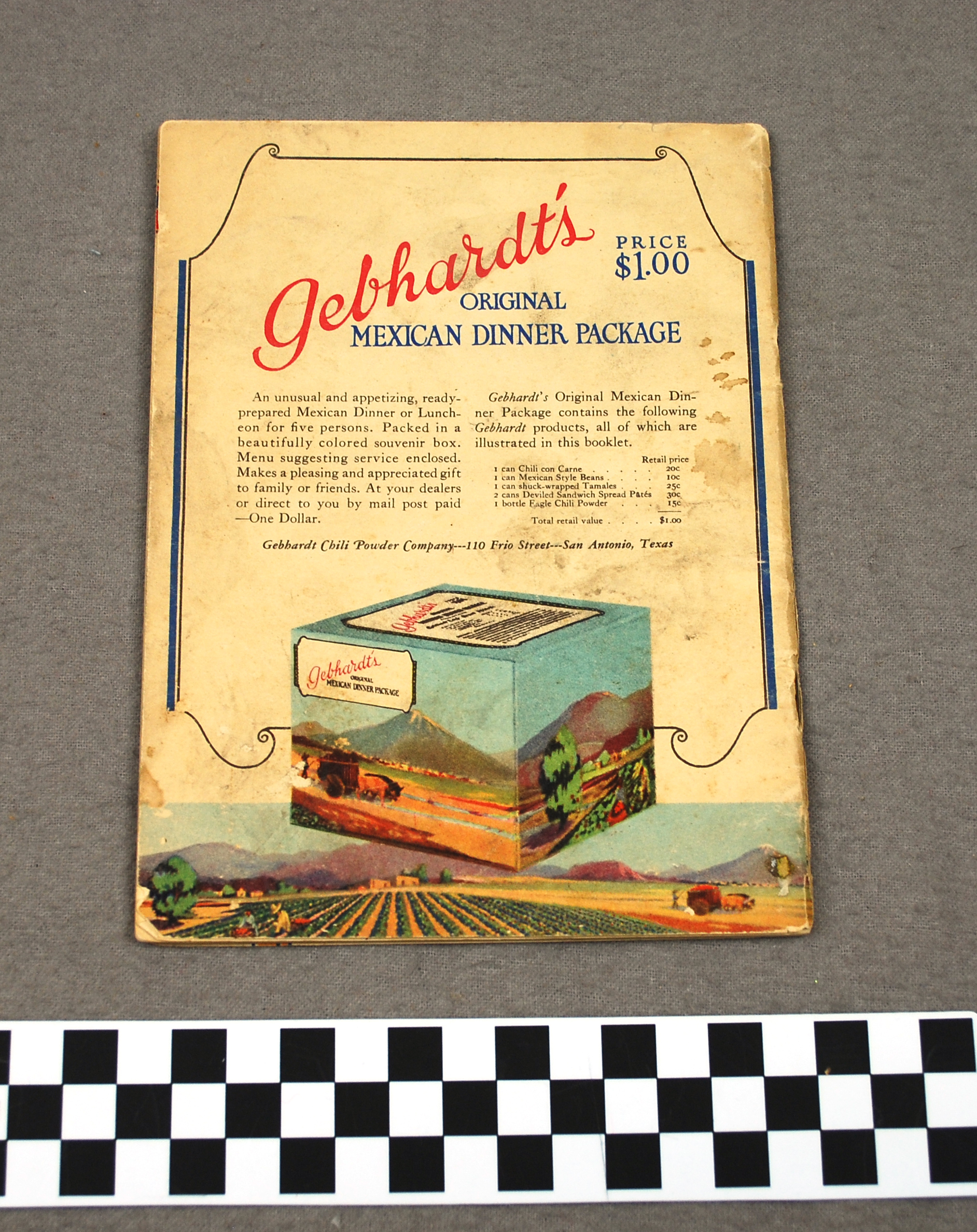This object is a pamphlet entitled “Mexican Cookery in American Homes” containing recipes by Willie Gebhardt, the inventor of Chili Powder. William Fredrick Gebhardt was born in Germany in 1875. His family immigrated to the United States and settled in New Braunfels. Willie had a passion to cook and opened a café in 1892, that he owned for 4 years. While living in New Braunfels, Willie met his wife Rose Mary Kronkosk. Gebhardt would often visit San Antonio roughly 30 miles south of New Braunfels and was fascinated by the variety of spicy Mexican food available. Willie soon began to experiment cooking with different chilies. In his café Willie served chili to his patrons and gained a reputation as a great chili cook. At this time people all over Texas knew about chili and enjoyed it with venison which was easily found around the country side. Although popular, chili was a seasonal food and only served from late spring through summer. During the 1800s it was difficult to keep chilies fresh during the winter months but Willie discovered if he dried the chilies and ground them into powder the potency of the chilies would remain fresh.
Gebhardt decided to order ancho peppers from San Luis Potosi, Mexico. He ordered a wagon load so he could have a stock for an entire year. He continued to experiment with the chilies and came up with a method for grinding and mixing them to transform them into what is now known as chili powder, or as he called it “Tampico dust.” Willie would package the chili powder and sell it around town. In 1896 Willie registered his trademark chili and changed the name to Gebhardt’s Eagle Brand Chili Powder. He also opened an establishment in San Antonio to manufacture the chili powder. The Powder was a huge success, however, the market for chili did not go beyond Texas because few Americans living outside of the state knew how to cook with chili powder.
In order to get Americans to embrace chili powder a cookbook entitled “Mexican Cooking” was created. This cookbook was one of the first Tex-Mex cookbooks. By the time Gebhardt received his butchers license in 1908 the name of the company had changed to Gebhardt’s Chili Powder Company. Tamales as well as canned chili con carne were added to the items sold by the company. Although Gebhardt was the first person to make a large scale business from selling chili con carne he was not the first to sell it. In fact there was a whole culture surrounding the sell of chili con carne in the city of San Antonio.
From the 1860s till the late 1930s women called the Chili Queens would sell chili con carne and other Tex-Mex and Mexican foods outside in the plazas from dusk until dawn. The plazas had a festive atmosphere filled with musicians and singers. Many authors who passed by San Antonio and encountered the Chili Queens wrote about them in their stories. Travelers passing by San Antonio were also fans of the Chili Queens. The Chili Queens were in business until about 1940 when they were shut down by the health department. San Antonio however, became a forerunner in the production of Tex-Mex food which included William Gebhardt’s foods, as well as Pace Picante Sauce, and Fritos.
As the Gebhardt company grew more cookbooks were created, and advertising for it was everywhere including radio commercials, and newspapers and magazines. The slogans for the ads included sayings like “Gebhardt’s. If you think its just a great chili, you might be missing something.” Willie Gebhardt died in 1956 at the age of 81. By this time he had been retired from the business for 20 years. The company was acquired by a Chicago based company in 1960 and that company was acquired by another. In 1984 the company was renamed Gebhardt Mexican Foods Company and sales increased in places like California, Arizona, and Oregon. Some products can be found in Texas stores like H.E.B. and today chili powder is one of the most common seasonings found in American homes.
